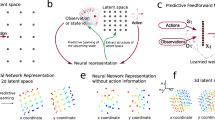Abstract
The recurrent perceptron RP-1—a combination of the Rosenblatt perceptron and the Jordan network—is proposed. As a result, the perceptron acquires properties of recurrent neural networks, while the learning remains as fast and efficient as in the conventional Rosenblatt model. The recurrent perceptron is tested on the example of an agent education problem, where the “student” is placed into a model environment.
Similar content being viewed by others
References
Rosenblatt, F., Principles of Neurodynamics (Perceptrons and the Theory of Brain Mechanisms), Washington D.C.: Spartan Books, 1962.
Rumelhart, D.E., Hinton, G.E., and Williams, R.J., Learning Internal Representations by Error Propagation, Parallel distributed processing: Explorations of the Microstructure of Cognition, Cambridge: MIT Press, 1986, pp. 318–362.
Wasserman, P., Neurocomputing: Theory and Practice, New York: Van Nostrand Reinhold, 1990.
Bongard, M.M., The Recognition Problem, Moscow: Nauka, 1967.
Elman, J.L. Finding Structure in time, Cognitive Science, 1990, vol. 14, pp. 179–211.
Jordan, M.I., Serial Order: a Parallel Distributed Processing Approach. Institute of Cognitive Science, University of California, San Diego, 1986, Report 8604.
Haykin S. Neural Networks: A Comprehensive Foundation, 2nd edition, Upper Saddle River, NJ: Prentice Hall, 1998.
Kussul E., Baiduk T., Kasatkina L., Lukovich V., Rosenblatt Perceptrons for Handwritten Digit Recognition, IEEE 0-7803-7044-9, pp. 1516–2001.
Kussul E., Baiduk T., An Improved Method of Handwritten Digit Recognition Tested on MNIST Database, Image and Vision Computing, 2004, vol. 22, pp. 971–981.
Author information
Authors and Affiliations
Corresponding author
Additional information
Original Russian Text © S.S. Yakovlev, A.N. Borisov, 2009, published in Avtomatika i Vychislitel’naya Tekhnika, 2009, No. 1, pp. 46–55.
About this article
Cite this article
Yakovlev, S.S., Borisov, A.N. A synergy of the Rosenblatt perceptron and the Jordan recurrence principle. Aut. Conrol Comp. Sci. 43, 31–39 (2009). https://doi.org/10.3103/S0146411609010052
Received:
Accepted:
Published:
Issue Date:
DOI: https://doi.org/10.3103/S0146411609010052




